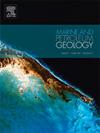外喀尔巴阡褶皱冲断带油气沉积逆时偏移成像研究
IF 3.6
2区 地球科学
Q1 GEOSCIENCES, MULTIDISCIPLINARY
引用次数: 0
摘要
西外喀尔巴阡褶皱冲断带是一个构造扰动强烈的岩层,其特征是陡倾、狭窄的褶皱。利用该地区的地震调查结果,评价了利用逆时偏移(PreSDM RTM)处理流程进行叠前深度偏移的效率,以增强和细化地质构造的地震成像。重点分析了早在地震方法应用于油气勘探之前,利用地表地质填图方法发现的三个油气聚集的地震成像。RTM算法应用的关键问题是高精度地震速度场的构建。在本研究中,采用了重力反演和早到达波形反演两种反演方法,采用测井数据和标准折射层析成像的初速度模型。PreSDM RTM的有效性通过各向同性和各向异性算法进行了评估,特别是由于地质结构的原因,采用了TTI各向异性变量。结果表明,RTM偏移能够成像喀尔巴阡褶皱-冲断带中陡密褶皱或小位移断层等强烈构造扰动构造的复杂细节。TTI RTM算法获得了最佳的地震成像效果,该算法的另一个优势是可以精确定位褶皱顶点的水平位置,从而形成潜在的油气圈闭,这对钻井地点的合理定位至关重要。浅层油气成藏成像效果好,钻井识别了浅层油气地质构造,证实了RTM的有效性。本文章由计算机程序翻译,如有差异,请以英文原文为准。
Cutting-edge reverse time migration imaging of the hydrocarbon deposits in the Outer Carpathian fold-thrust belt
The Western Outer Carpathian fold-thrust belt is an example of strongly tectonically disturbed rock formations characterized by steeply dipping, narrow folds. The results of seismic surveys conducted in that region were used to evaluate the efficiency of the Pre-Stack Depth Migration using Reverse Time Migration (PreSDM RTM) processing workflow to enhance and detail the seismic imaging of geological structures. The analysis focused on seismic imaging of three hydrocarbon accumulations discovered using surface geological mapping methods long before the seismic methods were implemented into the hydrocarbon exploration.
The key problem in the application of the RTM algorithm is the construction of a highly accurate seismic velocity field. In this study, two inversion methods were used for this purpose: gravity inversion and the Early Arrival Waveform Inversion, employing as initial velocity model one derived from well-log data and standard refraction tomography. The effectiveness of the PreSDM RTM was assessed using both isotropic and anisotropic algorithms, particularly employing the TTI anisotropy variant due to the geological structure.
The results obtained showed that RTM migration enables the imaging of challenging details of strongly tectonically disturbed structures in the Carpathian fold-thrust belt, such as steep and tight folds or small-displacement faults. The best seismic imaging was achieved using TTI RTM algorithm, whose additional advantage is the accurate horizontal positioning of fold culminations being potential hydrocarbon traps, which is crucial for the proper location of drilling sites. The RTM efficacy was confirmed by good imaging of shallow hydrocarbon accumulations, whose geological structure is recognized by drillings.
求助全文
通过发布文献求助,成功后即可免费获取论文全文。
去求助
来源期刊

Marine and Petroleum Geology
地学-地球科学综合
CiteScore
8.80
自引率
14.30%
发文量
475
审稿时长
63 days
期刊介绍:
Marine and Petroleum Geology is the pre-eminent international forum for the exchange of multidisciplinary concepts, interpretations and techniques for all concerned with marine and petroleum geology in industry, government and academia. Rapid bimonthly publication allows early communications of papers or short communications to the geoscience community.
Marine and Petroleum Geology is essential reading for geologists, geophysicists and explorationists in industry, government and academia working in the following areas: marine geology; basin analysis and evaluation; organic geochemistry; reserve/resource estimation; seismic stratigraphy; thermal models of basic evolution; sedimentary geology; continental margins; geophysical interpretation; structural geology/tectonics; formation evaluation techniques; well logging.
 求助内容:
求助内容: 应助结果提醒方式:
应助结果提醒方式:


